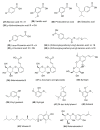A Review of the Ephedra genus: Distribution, Ecology, Ethnobotany, Phytochemistry and Pharmacological Properties
- PMID: 32698308
- PMCID: PMC7397145
- DOI: 10.3390/molecules25143283
A Review of the Ephedra genus: Distribution, Ecology, Ethnobotany, Phytochemistry and Pharmacological Properties
Abstract
Ephedra is one of the largest genera of the Ephedraceae family, which is distributed in arid and semiarid regions of the world. In the traditional medicine from several countries some species from the genus are commonly used to treat asthma, cold, flu, chills, fever, headache, nasal congestion, and cough. The chemical constituents of Ephedra species have been of research interest for decades due to their contents of ephedrine-type alkaloids and its pharmacological properties. Other chemical constituents such as phenolic and amino acid derivatives also have resulted attractive and have provided evidence-based supporting of the ethnomedical uses of the Ephedra species. In recent years, research has been expanded to explore the endophytic fungal diversity associated to Ephedra species, as well as, the chemical constituents derived from these fungi and their pharmacological bioprospecting. Two additional aspects that illustrate the chemical diversity of Ephedra genus are the chemotaxonomy approaches and the use of ephedrine-type alkaloids as building blocks in organic synthesis. American Ephedra species, especially those that exist in Mexico, are considered to lack ephedrine type alkaloids. In this sense, the phytochemical study of Mexican Ephedra species is a promising area of research to corroborate their ephedrine-type alkaloids content and, in turn, discover new chemical compounds with potential biological activity. Therefore, the present review represents a key compilation of all the relevant information for the Ephedra genus, in particular the American species, the species distribution, their ecological interactions, its ethnobotany, its phytochemistry and their pharmacological activities and toxicities, in order to promote clear directions for future research.
Keywords: Ephedra species; endophytic fungi; ephedrine-type alkaloids; ethnobotany; pharmacology; specialized metabolites; toxicity.
Conflict of interest statement
The authors declare no conflict of interest.
Figures













References
-
- Wong-Paz J.E., Contreras-Esquivel J.C., Rodríguez-Herrera R., Carrillo-Inungaray M.L., López L.I., Nevárez-Moorillón G.V., Aguilar C.N. Total phenolic content, in vitro antioxidant activity and chemical composition of plant extracts from semiarid Mexican region. Asian Pac. J. Trop. Med. 2015;8:104–111. doi: 10.1016/S1995-7645(14)60299-6. - DOI - PubMed
-
- Hollander J.L., Vander Wall S.B., Baguley J.G. Evolution of seed dispersal in North American Ephedra. Evol. Ecol. 2010;24:333–345. doi: 10.1007/s10682-009-9309-1. - DOI
-
- Ickert-Bond S.M., Renner S.S. The Gnetales: Recent insights on their morphology, reproductive biology, chromosome numbers, biogeography, and divergence times. J. Syst. Evol. 2016;54:1–16. doi: 10.1111/jse.12190. - DOI
Publication types
MeSH terms
Substances
Grants and funding
LinkOut - more resources
Full Text Sources

